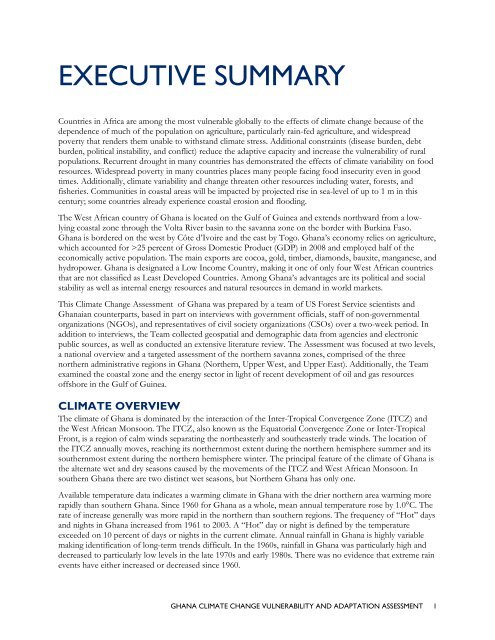ghana climate change vulnerability and adaptation assessment
ghana climate change vulnerability and adaptation assessment
ghana climate change vulnerability and adaptation assessment
- No tags were found...
You also want an ePaper? Increase the reach of your titles
YUMPU automatically turns print PDFs into web optimized ePapers that Google loves.
EXECUTIVE SUMMARYCountries in Africa are among the most vulnerable globally to the effects of <strong>climate</strong> <strong>change</strong> because of thedependence of much of the population on agriculture, particularly rain-fed agriculture, <strong>and</strong> widespreadpoverty that renders them unable to withst<strong>and</strong> <strong>climate</strong> stress. Additional constraints (disease burden, debtburden, political instability, <strong>and</strong> conflict) reduce the adaptive capacity <strong>and</strong> increase the <strong>vulnerability</strong> of ruralpopulations. Recurrent drought in many countries has demonstrated the effects of <strong>climate</strong> variability on foodresources. Widespread poverty in many countries places many people facing food insecurity even in goodtimes. Additionally, <strong>climate</strong> variability <strong>and</strong> <strong>change</strong> threaten other resources including water, forests, <strong>and</strong>fisheries. Communities in coastal areas will be impacted by projected rise in sea-level of up to 1 m in thiscentury; some countries already experience coastal erosion <strong>and</strong> flooding.The West African country of Ghana is located on the Gulf of Guinea <strong>and</strong> extends northward from a lowlyingcoastal zone through the Volta River basin to the savanna zone on the border with Burkina Faso.Ghana is bordered on the west by Côte d’Ivoire <strong>and</strong> the east by Togo. Ghana’s economy relies on agriculture,which accounted for >25 percent of Gross Domestic Product (GDP) in 2008 <strong>and</strong> employed half of theeconomically active population. The main exports are cocoa, gold, timber, diamonds, bauxite, manganese, <strong>and</strong>hydropower. Ghana is designated a Low Income Country, making it one of only four West African countriesthat are not classified as Least Developed Countries. Among Ghana’s advantages are its political <strong>and</strong> socialstability as well as internal energy resources <strong>and</strong> natural resources in dem<strong>and</strong> in world markets.This Climate Change Assessment of Ghana was prepared by a team of US Forest Service scientists <strong>and</strong>Ghanaian counterparts, based in part on interviews with government officials, staff of non-governmentalorganizations (NGOs), <strong>and</strong> representatives of civil society organizations (CSOs) over a two-week period. Inaddition to interviews, the Team collected geospatial <strong>and</strong> demographic data from agencies <strong>and</strong> electronicpublic sources, as well as conducted an extensive literature review. The Assessment was focused at two levels,a national overview <strong>and</strong> a targeted <strong>assessment</strong> of the northern savanna zones, comprised of the threenorthern administrative regions in Ghana (Northern, Upper West, <strong>and</strong> Upper East). Additionally, the Teamexamined the coastal zone <strong>and</strong> the energy sector in light of recent development of oil <strong>and</strong> gas resourcesoffshore in the Gulf of Guinea.CLIMATE OVERVIEWThe <strong>climate</strong> of Ghana is dominated by the interaction of the Inter-Tropical Convergence Zone (ITCZ) <strong>and</strong>the West African Monsoon. The ITCZ, also known as the Equatorial Convergence Zone or Inter-TropicalFront, is a region of calm winds separating the northeasterly <strong>and</strong> southeasterly trade winds. The location ofthe ITCZ annually moves, reaching its northernmost extent during the northern hemisphere summer <strong>and</strong> itssouthernmost extent during the northern hemisphere winter. The principal feature of the <strong>climate</strong> of Ghana isthe alternate wet <strong>and</strong> dry seasons caused by the movements of the ITCZ <strong>and</strong> West African Monsoon. Insouthern Ghana there are two distinct wet seasons, but Northern Ghana has only one.Available temperature data indicates a warming <strong>climate</strong> in Ghana with the drier northern area warming morerapidly than southern Ghana. Since 1960 for Ghana as a whole, mean annual temperature rose by 1.0°C. Therate of increase generally was more rapid in the northern than southern regions. The frequency of “Hot” days<strong>and</strong> nights in Ghana increased from 1961 to 2003. A “Hot” day or night is defined by the temperatureexceeded on 10 percent of days or nights in the current <strong>climate</strong>. Annual rainfall in Ghana is highly variablemaking identification of long-term trends difficult. In the 1960s, rainfall in Ghana was particularly high <strong>and</strong>decreased to particularly low levels in the late 1970s <strong>and</strong> early 1980s. There was no evidence that extreme rainevents have either increased or decreased since 1960.GHANA CLIMATE CHANGE VULNERABILITY AND ADAPTATION ASSESSMENT 1
















